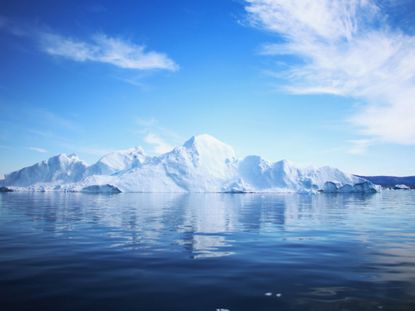Ancient landscapes revealed as Arctic glaciers melt
New study suggests region may be experiencing its warmest century in 115,000 years

Rising temperatures in the Arctic has led to the exposure of ancient landscapes that have been hidden under glaciers for more than 40,000 years, researchers say.
According to a study outlined in a newly published paper in journal Nature Communications, scientists collected 48 plant samples that had been covered by ice for hundreds of centuries on Baffin Island, part of the Canadian territory of Nunavut.
The team, from the University of Colorado Boulder, “also collected quartz from these areas to help determine the age and history of ice coverage”, reports USA Today.
Subscribe to The Week
Escape your echo chamber. Get the facts behind the news, plus analysis from multiple perspectives.

Sign up for The Week's Free Newsletters
From our morning news briefing to a weekly Good News Newsletter, get the best of The Week delivered directly to your inbox.
From our morning news briefing to a weekly Good News Newsletter, get the best of The Week delivered directly to your inbox.
They then used radiocarbon dating to estimate “death dates” for the plants, measuring the amounts of naturally occurring isotopes that decayed at certain rates over time. Their findings showed the plants had all died at least 400 centuries ago - “right in the middle of the last glacial period”, study author Simon Pendleton, a doctoral researcher at the university’ Institute of Arctic and Alpine Research, told Vice’s Motherboard.
When compared against temperature data reconstructed from Baffin and Greenland ice cores, the findings suggest that modern temperatures represent the warmest century for the region in 115,000 years, says ScienceDaily.
And “these trends are likely to continue and remove all ice from Baffin Island within the next few centuries, even in the absence of additional summer warming”, the scientists add in their report.
Earlier this month, a report from researchers at the University of California Irvine found ice in Antarctica is melting six times faster than it did 40 years ago. The melting has caused global sea levels to rise more than half an inch since 1979, the study found.
Create an account with the same email registered to your subscription to unlock access.
Sign up for Today's Best Articles in your inbox
A free daily email with the biggest news stories of the day – and the best features from TheWeek.com
-
 Today's political cartoons - April 18, 2024
Today's political cartoons - April 18, 2024Cartoons Thursday's cartoons - impeachment Peanuts, record-breaking temperatures, and more
By The Week US Published
-
 Pros and cons of solar energy
Pros and cons of solar energyPros and cons Solar power could become the primary source of electricity worldwide by 2050 – but there are still clouds in the forecast
By Rebecca Messina, The Week UK Published
-
 Post Office's Capture software to be reviewed over 'glitches'
Post Office's Capture software to be reviewed over 'glitches'Speed Read Solicitor representing accused postmasters says flaws in the IT system follow 'very similar pattern' to Horizon
By Arion McNicoll, The Week UK Published
-
 Woman accidentally puts nan in washing machine
Woman accidentally puts nan in washing machineTall Tales And other stories from the stranger side of life
By Chas Newkey-Burden, The Week UK Published
-
 'Angel' visits woman before lottery win
'Angel' visits woman before lottery winTall Tales And other stories from the stranger side of life
By Chas Newkey-Burden, The Week UK Published
-
 Doomsday group offers 'epic' survival opportunity
Doomsday group offers 'epic' survival opportunityTall Tales And other stories from the stranger side of life
By Chas Newkey-Burden, The Week UK Published
-
 Puffed rice and yoga: inside the collapsed tunnel where Indian workers await rescue
Puffed rice and yoga: inside the collapsed tunnel where Indian workers await rescueSpeed Read Workers trapped in collapsed tunnel are suffering from dysentery and anxiety over their rescue
By Sorcha Bradley, The Week UK Published
-
 Gaza hospital blast: What the video evidence shows about who's to blame
Gaza hospital blast: What the video evidence shows about who's to blameSpeed Read Nobody wants to take responsibility for the deadly explosion in the courtyard of Gaza's al-Ahli Hospital. Roll the tape.
By Peter Weber, The Week US Published
-
 Giraffe poo seized after woman wanted to use it to make a necklace
Giraffe poo seized after woman wanted to use it to make a necklaceTall Tales And other stories from the stranger side of life
By Chas Newkey-Burden, The Week UK Published
-
 Helicopter sound arouses crocodiles
Helicopter sound arouses crocodilesTall Tales And other stories from the stranger side of life
By Chas Newkey-Burden, The Week UK Published
-
 Woman sues Disney over 'injurious wedgie'
Woman sues Disney over 'injurious wedgie'Tall Tales And other stories from the stranger side of life
By Chas Newkey-Burden, The Week UK Published